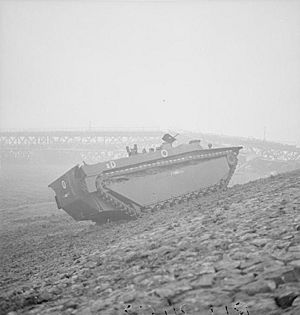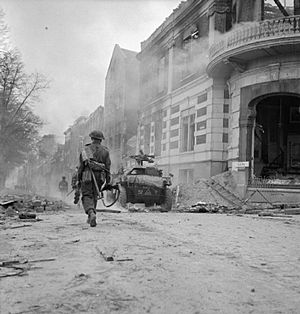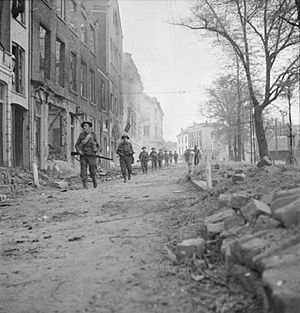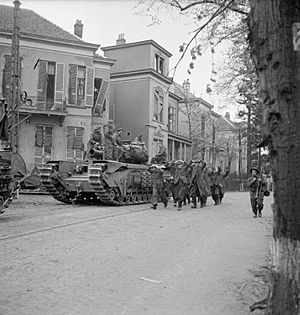Liberation of Arnhem facts for kids
Quick facts for kids Operation Anger |
|||||||
|---|---|---|---|---|---|---|---|
| Part of the Western Front of 1944-45 in the European theatre of World War II | |||||||
 A Sherman Crab Flail Tank outside burning buildings in Arnhem, 14 April. |
|||||||
|
|||||||
| Belligerents | |||||||
| Commanders and leaders | |||||||
| Strength | |||||||
| 1 infantry division plus armoured support |
*Estimated over 1,000 men | ||||||
| Casualties and losses | |||||||
| 62 killed 134 wounded |
#Casualties unknown 600 captured |
||||||
| *More details of the German strength can be found in the German forces section #More detailed information is available in the aftermath section |
|||||||
Operation Anger was a military plan to capture the city of Arnhem in the Netherlands. This happened in April 1945, near the end of World War II. It is also known as the Second Battle of Arnhem or the Liberation of Arnhem. This operation was part of the Canadian First Army's mission to free the Netherlands. The main group leading the attack was the 49th British Infantry Division. They had help from Canadian tanks, Royal Air Force planes, and Royal Navy boats.
The Allied forces first tried to free Arnhem in September 1944. This was during a big plan called Operation Market Garden. But bad planning and strong German forces led to the defeat of the 1st British Airborne Division. The battle line then stayed south of Arnhem for the winter. New plans to take Arnhem began in early 1945. The Canadian First Army wanted to connect its different units. By April, taking Arnhem became possible. After Canadian troops secured the eastern bank of the IJssel River, the main Canadian army prepared to attack Arnhem.
The operation started on April 12, 1945. It went mostly as planned. Three infantry brigades of the 49th Division took turns advancing through the city. Within four days, the Allies had full control of Arnhem. This allowed the Canadian forces to move further into the Netherlands. Less than two weeks after the battle, a temporary stop to fighting began. On May 5, the German commander in the Netherlands surrendered to the Canadian Army. Three days later, Germany surrendered completely, ending the war in Europe.
Contents
Why Arnhem Was Important
The First Battle for Arnhem
In September 1944, the Allies launched Operation Market Garden. This was a big plan to get around German defenses and open a path into Germany. The British 1st Airborne Division landed near Arnhem. They fought for nine days in and around the city. But the British ground forces could not reach them in time. The airborne troops were almost completely wiped out. After this, the battle line settled south of the city for the winter.
The people living in Arnhem and Oosterbeek were forced to leave their homes. German soldiers then took anything valuable from the empty houses. The damaged towns were turned into strong defense spots. The Arnhem road bridge, which the British had fought hard for, was bombed by the Allies in October 1944. This was to stop the Germans from using it. Arnhem was also heavily shelled by the Allies during the winter. It was even hit by German V-2 rockets. The Germans also stopped all train movement in the Netherlands. This was because Dutch railway workers had gone on strike to help the Allies. This caused severe food shortages in the west of the country. This period is known as the Hongerwinter, or "Hunger Winter."
Allies Cross the Rhine River
In early 1945, the Allies pushed into Germany. This cleared the way for more crossings of the River Rhine. The main Allied army group then moved quickly into northwest Germany. Meanwhile, the First Canadian Army was given the job of freeing the Netherlands.
The Canadian Army had been planning to cross the Lower Rhine since November. But these plans were delayed by winter. After a major battle in Germany, the Canadian commander, Henry Crerar, saw a chance to take Arnhem. He wanted to open a route to Emmerich. The first plan to take Arnhem was made in February. It was called Operation Anger. But the commander of the Canadian troops, Charles Foulkes, thought it was safer to wait. He wanted to cross the Rhine first. So, the plan for Arnhem was put on hold.
After the Rhine crossing, Canadian troops moved west and captured Emmerich. They approached the IJssel River from the east. General Crerar saw an opportunity to take Arnhem. He ordered his two main army groups to work together. But he was careful. He did not want to attack Arnhem until the IJssel River was crossed further north.
In March, the 49th (West Riding) Division joined the Canadian forces. On April 2, this division, with Canadian support, cleared the area known as the "Island." This attack was timed to happen when other Canadian troops cleared the east bank of the IJssel. On April 3, some Canadian units crossed the Nederrijn River. They met other Canadian units near Arnhem. The rest of the "Island" was cleared within a day. The Allies then held the south bank of the Nederrijn. They were ready to attack Arnhem.
The first plan for Operation Anger was to cross the Nederrijn right away. But on April 3 and 4, patrols found strong German positions. These positions overlooked the river. This made crossing the Nederrijn very dangerous. The Allies tried to use smoke to hide their movements. But strong winds made the smoke screens less effective. Also, the ground was getting worse. So, on April 7, the decision was made to attack Arnhem from the east, across the IJssel River.
Getting Ready for Battle
Allied Forces Prepare
The attack was delayed while the 49th Division moved into position. This caused big traffic jams on the roads. There was worry that the Germans would have time to prepare. But it turned out they did not have enough soldiers or equipment to improve their defenses.
The attack was planned in three steps. First, the 56th British Infantry Brigade would cross the IJssel at night. They would use special amphibious vehicles called Buffalo IVs. They would clear the eastern and southern parts of the city. In the second step, the 146th British Infantry Brigade would move forward. They would attack the higher ground north of Arnhem. In the third step, the 147th British Infantry Brigade would advance. They would secure the high ground west of the city. Once the high ground was safe, the 5th Canadian Armoured Division would move through Arnhem.
The British forces had help from several Canadian units. They also had special Churchill Crocodile tanks. These tanks could shoot flames. The Royal Navy provided 45 landing craft to help cross the river. The Royal Canadian Engineers would build four temporary bridges. They would also use a special prefabricated bridge. This bridge was built beforehand and floated into place. Canadian soldiers also created a heavy smoke screen over Arnhem. This was to hide their movements and confuse the Germans.
Allied Units in the Battle
- 49th (West Riding) Infantry Division
- 56th Infantry Brigade
- 146th Infantry Brigade
- 147th Infantry Brigade
- Units from the 5th Canadian Armoured Division
- Units from the 79th British Armoured Division
German Forces Ready
The German forces in the Netherlands were called "Fortress Holland." It was hard for the Allies to know exactly how many German soldiers were north of the Rhine. About 10,000 German troops were thought to be in the Arnhem area. This included parts of the 346th Infantry Division and other units. Arnhem itself had been turned into a strong defense area after the battle the year before. On the very day the attack on Arnhem began, the German leader Heinrich Himmler ordered that all cities must be defended at any cost. If a city was not defended, the punishment was death.
The Battle Begins
On April 11, Canadian forces crossed the IJssel River further north. They then moved west toward Apeldoorn. On the morning of April 12, the commander of the 49th Division was told to start their attack that evening. The whole day was spent bombing German positions in Arnhem. The British Royal Air Force used Spitfire and Typhoon planes to soften up the German defenses. The attack started with one of the heaviest artillery bombardments ever fired by the Canadian forces. One group of eight guns fired 640 shells in just ten minutes. Soldiers also fired 30,000 smoke shells during the battle. A fake attack from south of the Nederrijn made the Germans react strongly. This suggested they expected the main attack from the south, not the east.
First Step of the Attack
The first part of the attack did not go perfectly. The crossing was supposed to start at 10:40 PM but was delayed. Some explosives meant to clear a path through landmines did not go off. Also, some of the Buffalo vehicles were not working. So, the companies had to cross the river separately instead of all at once. Despite this, the first company reached the west bank of the IJssel at 11:15 PM. They began to take their targets with little resistance. They secured the area for the temporary bridge. At 12:50 AM, Canadian engineers began floating parts of the bridge into place. The second wave of soldiers crossed the river under heavy German fire. Their boats drifted downstream, but once ashore, they moved quickly into the city. However, their advance slowed. Another battalion was sent to help them. By 7:00 AM, more soldiers were across the river. By 8:45 AM, a temporary ferry was set up to move tanks across.
Second Step of the Attack
The Canadian engineers kept building the bridge all night. Twelve hours after the attack began, vehicles were crossing the IJssel. This allowed the second step of the operation to start. Soon, more British soldiers and tanks were moving into position. There was little resistance in the morning. However, some British soldiers had to fight off a German counterattack near the railway. Later in the morning, the British advanced toward a large factory complex. German soldiers had set up a strong defense there. The British, with tank support, eventually overwhelmed the Germans. This battle lasted most of the day. By the evening of April 13, most of the German resistance in the city was broken. The 147th Brigade was getting ready to cross into Arnhem.
Third Step of the Attack
The 147th Brigade crossed the Nederrijn overnight. By the morning of April 14, they were ready to move through the city. By now, the German defense was falling apart. But the British soldiers found many mines and destroyed areas as they advanced. One company of soldiers ambushed what they thought were German tanks. It turned out the Germans had no idea the British were there. Later that day, Dutch soldiers fighting for the Germans, supported by tanks, counterattacked. The Dutch were eventually pushed back after heavy fighting. By the end of the day, the Allied units had reached all their goals. Most of Arnhem was safe. The 5th Canadian Armoured Division began moving to the high ground north of the city that night. There, they met special forces units who had been working behind enemy lines. On April 15, British soldiers occupied the city's zoo. They found a live polar bear and offered it to their commander, who said no. The Germans were cleared out of the surrounding area on April 15 and 16. This brought Operation Anger to an end.
What Happened Next
The Allies freed a city that was completely ruined. After the looting the year before, houses were empty. They had no furniture, goods, or even doors. One reporter called the city "a deserted, burning shell." The war diary of the 49th Division said that "a town had never been more wantonly destroyed." Signs of the first battle of Arnhem were everywhere. Freeing the city was like "entering an ancient tomb."
The Allied advance continued right away. The 5th Canadian Armoured Division moved through Arnhem toward the high ground north of the city. They were given a new mission to secure towns between Arnhem and the IJsselmeer. A large German force counterattacked the 5th Division on the night of April 16. They hoped to break out to the west. But they were pushed back after heavy losses. On April 17, the 49th Division attacked Ede, a town held by Dutch soldiers fighting for the Germans. They freed the town in 24 hours. On April 27, a temporary stop to fighting began. This allowed food aid to be given to the hungry Dutch people in German-controlled areas. On May 5, the German commander in the Netherlands agreed to surrender all German forces.
The British reported 62 soldiers killed and 134 wounded in the battle. It is not clear if this includes Canadian casualties. The number of German prisoners of war varies in different reports, from 601 to 1,600. The number of German casualties is also unknown, but could have been as high as 3,000. Most of the Allied soldiers killed in the battle were buried at the Arnhem Oosterbeek War Cemetery after the war. German soldiers were reburied at Ysselsteyn. Units involved in the battle were later given the special honor "Arnhem 1945."






